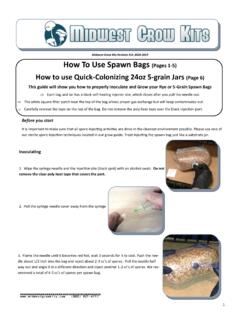Transcription of GUIDANCE ON DISTANCE LEARNING MODALITIES
1 IGuidance on DISTANCE LEARNING Modalitiesfor every childGUIDANCE ON DISTANCE LEARNING MODALITIESTO REACH ALL CHILDREN AND YOUTH DURING SCHOOL CLOSURESF ocusing on low- and no-tech MODALITIES to reach the most marginalizediiGuidance on DISTANCE LEARNING ModalitiesUNICEF Regional Office for South AsiaLainchaur, Lekhnath MargKathmandu, NepalTelephone: +977 1 441 7082 Facsimile: +977 1 441 9479E-mail: photo: UNICEF/UNI45507/Noorani United Nations Children s Fund (UNICEF) Regional Office for South Asia 2020 Rights and PermissionsThis work is available under the Creative Commons Attribution IGO license (CC BY IGO)iiiGuidance on DISTANCE LEARNING ModalitiesGUIDANCE ON DISTANCE LEARNING MODALITIES TO REACH ALL CHILDREN AND YOUTH DURING SCHOOL CLOSURESF ocusing on low- and no-tech MODALITIES to reach the most marginalizedivGuidance on DISTANCE LEARNING MODALITIES UNICEF/UN072727/Latif 1 ABOUT THIS GUIDANCE 21.
2 DISTANCE LEARNING IN THE CONTEXT OF SCHOOL CLOSURES DUE TO COVID-19 32. ENSURING CONTINUITY OF LEARNING DURING SCHOOL CLOSURES 6 Use a combination of LEARNING MODALITIES 6 Establish a one-stop portal with key resources and GUIDANCE 6 Encourage school leaders to take an active role 7 Ensure teachers continued engagement with their students 8 Engage parents and caregivers 8 Build the capacity of teachers, parents/caregivers and children 9 Develop and implement strategies to reach the most vulnerable children in times of school closures 10 Explore ways to provide free Internet access 10 Monitor reach and effectiveness of DISTANCE LEARNING MODALITIES and LEARNING progress 11 Continue DISTANCE LEARNING MODALITIES when schools reopen 123.
3 COMBINING SELF- LEARNING AND TEACHER-GUIDED MODALITIES 134. LEVERAGING LEARNING OPPORTUNITIES THROUGH BASIC MOBILE PHONES 16 Challenges and constraints when LEARNING through basic mobile phones 16 Opportunities for LEARNING through basic mobile phones 185. PRINTED LEARNING kits AND READING MATERIALS 21 CONTENTS2 GUIDANCE on DISTANCE LEARNING ModalitiesThis GUIDANCE on continuity of LEARNING during school closures draws on the key lessons learned from the COVID-19 education response around the world. It was developed for government policymakers and education staff of national and international organizations involved in the education response during school is the first edition of the GUIDANCE .
4 ABOUT THIS GUIDANCE3 GUIDANCE on DISTANCE LEARNING ModalitiesThe COVID-19 pandemic has exposed large inequalities in access to technology, such as between rich and poor, rural and urban, girls and boys, across and within countries. Online platforms have often been the first to be rolled out to enable children to continue LEARNING from home; indeed, they are generally the most effective LEARNING modality in getting some form of LEARNING up and running. However, they have the lowest reach. In some countries, online platforms reach less than 10 per cent of the population. This is because they require electricity, reliable Internet connectivity, as well as sufficient devices for children in the household: particularly, devices with good functionality and capabilities, and large enough screen , another element of the digital divide concerns the digital literacy gap, a barrier that can be even harder to address.
5 There is also a significant gender digital divide, with girls far less likely to own or have access to digital devices, and fewer opportunities to gain digital literacy governments have therefore rolled out multiple LEARNING MODALITIES , including those which require no technology or technologies that are more commonly available. When planning such initiatives, it is helpful to UNICEF ROSA/2015/NyboDISTANCE LEARNING IN THE CONTEXT OF SCHOOL CLOSURES DUE TO COVID-1914 GUIDANCE on DISTANCE LEARNING Modalitiesdistinguish between high-tech MODALITIES (like online platforms and apps) and low- or no-tech MODALITIES (like TV, radio, SMS and printed LEARNING materials), which have the potential for much higher reach.
6 Another useful distinction is between one-way MODALITIES , requiring children to study independently though possibly supported by parents/caregivers1 or even older siblings and those which are teacher-guided. During school closures, it is important that teachers continue to engage and interact with their students, provide assignments and, importantly, provide timely feedback. This can be done, for example, through calls and SMS, or social media for those with connected LEARNING MODALITIES a total of 12 are summarized in the Home LEARNING 1. Noting that vulnerable and disadvantaged children and youth are more likely to be first-generation learners , and thus are less likely to have parental education support during school LEARNING MODALITIES Matrixhigh tech versus low/no tech and self- LEARNING versus teacher-guided Self- LEARNING *Teacher-guided1.
7 Printed materials, books2. Radio3. TVLow/no tech, offlineInteractive RadioInteractive Voice Response (IVR)Interactive SMS (RapidPro)Interactive TVHigh tech, onlineHOME LEARNING MODALITIES7. Digital (audio) books8. Feature phone apps9. Other apps/platforms10. Digital classrooms11. Video conferencing 12. Social Media4. Home visits5. Calls6. SMSMain focus for reaching disadvantaged children and youth *Ideally supported by parents/caregivers5 GUIDANCE on DISTANCE LEARNING Modalities2. See also the UNICEF Remote LEARNING COVID-19 Response Decision TreeThe following sections cover some of the key LEARNING MODALITIES and how they can be used for self- LEARNING or teacher-guided LEARNING during school closures, with a focus on low- and no-tech MODALITIES to reach the most disadvantaged and marginalized school closures, it is important that teachers continue to engage and interact with their students, provide assignments, and, importantly, provide timely feedback.
8 MODALITIES Matrix, across the four LEARNING classifications (the four corners in the matrix):21. Low/no tech self- LEARNING 2. Low/no tech teacher-guided learning3. High tech self- LEARNING 4. High tech teacher-guided learning6 GUIDANCE on DISTANCE LEARNING Modalities3. UNICEF has analysed technology reach for 127 countries based mainly on household survey data; another source for Internet/social media reach is Bangladesh MICS6, 2019 This section summarizes key considerations and recommendations for ensuring continuity of LEARNING during school Use a combination of LEARNING modalitiesTo address differential access to technology, multiple LEARNING MODALITIES are required, particularly those that are low tech or no tech the top half of the Home LEARNING MODALITIES Matrix.
9 For planning and prioritization, it is important to understand the extent of technology reach, including at subnational levels, by rural/urban, by gender and, if possible, by wealth Such an evidence-based analysis is an important component of a national plan or strategy for the education response and continuity of LEARNING during school closures. For example in Bangladesh, for school-age children in the poorest wealth quintile, less than 6 per cent have a television but over 92 per cent have a mobile phone in their Across countries, the penetration rate of mobile phones is consistently high, even in the poorest wealth quintile and in rural areas.
10 Section 4 of the GUIDANCE focuses specifically on LEARNING through basic mobile MODALITIES on their own ( , radio, TV, paper-based LEARNING kits and even online platforms and mobile apps) are unlikely to be very effective in ensuring LEARNING continuity if they are not complemented by teacher-guided MODALITIES . Teachers should continue to be involved to guide their students as well as support parents/caregivers during school closures (see section ). A combination of self- LEARNING and teacher-guided MODALITIES is therefore required (see section 3). When there are multiple LEARNING MODALITIES being rolled out (and ideally there are), it is important to integrate them within an overarching education strategy, anchored to the Establish a one-stop portal with key resources and guidanceIt is useful to have a single, regularly updated, national (government) portal or website that ENSURING CONTINUITY OF LEARNING DURING SCHOOL CLOSURES27 GUIDANCE on DISTANCE LEARNING Modalities5.













